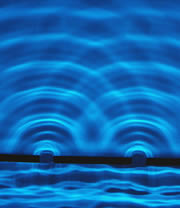Compounds found in cells show quantum behaviour.
 |
| A wave-like particle can pass through both slots in
a barrier. © SPL |
Physicists have watched biological molecules become waves in a dramatic demonstration of the effects of quantum mechanics1.
It's not clear that biological molecules act like quantum waves in this way as they go about their business in living cells. However, physicist Roger Penrose of the University of Oxford, UK, and psychologist Stuart Hameroff of the University of Arizona in Tucson have proposed that consciousness might arise from wave-like quantum-mechanical effects involving protein filaments called microtubules in nerve cells.
It would be going too far to suggest that the latest observations provide any support for this idea — for one thing, microtubules are much bigger and heavier than the molecules used in the new experiment. But they do demonstrate that the quantum world has wider boundaries than we might have supposed.
Scientists know that subatomic particles and individual atoms can behave like waves, in line with the famous quantum notion of wave-particle duality. But these properties are thought to give way to classical, billiard-ball-like behaviour as particles get larger. Quantum mechanics is needed to describe how large molecules vibrate, spin and move, but the molecules themselves are seen as occupying a well-defined position at any moment.
Wave-like objects, in contrast, are smeared out. A particle behaving like a wave can, for example, seem to pass through two slits in a barrier simultaneously. When this happens, the two waves emerging from the slits may interfere with each other.
Light waves produce a pattern of light and dark bands in two-slit experiments, where the beams alternately reinforce and cancel each other. Beams of quantum particles such as electrons generate a similar pattern.
In 1999, Markus Arndt and colleagues at the University of Vienna, Austria, reported an interference pattern from a beam of C60 molecules passed through an array of slits2. These molecules — hollow spheres made up of 60 carbon atoms, also known as buckyballs - were the biggest objects shown to exhibit quantum wave-like behaviour.
Now the Vienna group has seen an interference pattern for molecules of tetraphenylporphyrin (TPP). These plate-shaped molecules are twice the width of buckyballs. The core of a TPP molecule is a porphyrin chemical group, which is the key component of light-absorbing chlorophyll in plants and oxygen-binding haemoglobin in blood.
The researchers have also broken their own record for the heaviest objects seen to display wave-like interference, using fluorinated C60 molecules.
References
© Nature Publishing Group 2003 - NATURE NEWS SERVICE